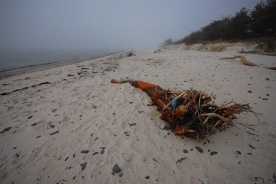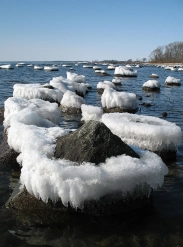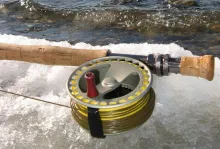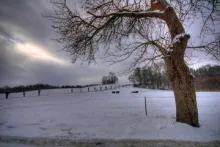How do you frame wind? How is snow captured best? How do you protect your camera when you try to freeze a shower into a single image? No, it's not at all easy to get the impression of weather into that piece of mechanics and electronics we call a camera.
How do you frame wind? How is snow captured best? How do you protect your camera when you try to freeze a shower into a single image? No, it's not at all easy to get the impression of weather into that piece of mechanics and electronics we call a camera.
But that shouldn't keep you from shooting when the weather turns bad, because you can get some of the best and most stunning images outdoors when the weather is bad - or at least different. Fog, wind, snow, rain. It should all get you scouting for subjects.
Bad weather is good weather!
Most people will regard sunshine and beautiful weather as the best photo weather. Sure enough: you do get some nice pictures in great weather. The sun is shining, clouds are drifting, the sky is blue and people are happy. When clouds draw over, the scene becomes dull and boring, and you tuck away the camera. When the rain sets in you pack up for good. The photo day is over.
No! It's not! Now the fun starts! Photographically at least.
Bad weather is generally very good photo weather, and the more extreme the better.
Dense fog.
Howling wind.
Drizzling rain.
Heavy snow.
Bring it on!
As soon as you bump into weather like that, you want to shoot and try to capture the rage of the elements with your camera.
Dense fog.
Howling wind.
Drizzling rain.
Heavy snow.
Bring it on!
Cameras endure more than you think
I admit that it's a bit borderline to dig out the camera when conditions are as worst, and I also admit that some cameras (or rather camera owners) will suffer a bit in the rough environment, but trust me: your camera will endure far more that you think. You need to leave that comfort zone and bring your camera out of protective covers, bags and Ziploc's and start shooting!
It's less than a year ago I bought my first waterproof camera. Until then I have been shooting with whatever fate and my wallet could manage to put in my hand. I have always aimed for the rugged, but never been extremely worried about rain, snow and dirt. And that attitude has brought me a lot of great pictures.
If you are extremely uncomfortable with hauling out a camera under harsh conditions, consider getting a bulletproof camera the next time you buy a new one. I recently bought a truly waterproof and shock proof Canon camera, and although it doesn't have quite as many control options as the ones I have used until now, it will stand almost whatever I offer it, including rain, submersion and falls from about 3-4 feet.
So, you got out your camera, and now what? How do you get the best weather pictures?
Rain or snow
Well, if it rains or snows you can consider using a slow shutter speed to catch the movement of the flakes or drops. The light will typically be low, but be careful with fill flash, because the light will most likely illuminate all the drops between you and the subject rather than the subject itself. If you flash, make sure to take a couple of shots without flash too.
Wind
If it blows, you need to capture motion in trees, bushes, clothes or water. If you are on a lake or the ocean, you can try to capture waves turning over. The best position for wave images is low - really low! Keep the camera as close to the surface as you dare. Follow the motion of the waves and press the shutter when the camera is between two waves.
Fog
Fog is one of the best kinds of weather you can bump into for fishing pictures. Some of my best fishing/weather images have been shot in foggy weather.
Fog gives that special ambiance, which we occasionally run into when fishing - especially if we get up early in the morning. An angler in the mist with a low, hazy sun in the background usually offers some really good subjects.
There are basically two angles to attack fog: telephoto or wideangle. The telephoto lens will render a lone angler in the distance blurry and enhance the sense of mist, while a closeup of an angler will isolate the person, but show the foggy background.
Frost
Frost is like wind. It's not easy to catch in a frame. But the results of frost are much more tangible. Ice on rocks and water, frost crystals in weed and grass, snow powdered leaves even slush ice in rod eyes or frozen drops on the line. For some of these subjects a macro may be handy, but in most cases any standard lens will do.
- Log in to post comments

































Greetings Martin, Wh
Greetings Martin, What can I say after such a comprehensive reply!? There are equipment collectors - and obviously - there are eqipment destroyers!
Interesting that none of the dry and wait tehniques have ever worked for me - fresh or salt water. I don't have the camea corpses to display as the insurance company claimed them - probably as proof of the claim. Loved the link to your site - have bookmarked it for future visits!
Wolfie, Oh I have
Wolfie,
Oh I have drowned cameras! My list is almost as long as yours (4 PowerShots), and I even documented it and wrote a bit about it:
Three down and one to go. The front one works, the rest are all dead or semi dead:
This one is definitely under! Notice the shrimp!
Post mortem reconstruction...
And more here: How to drown a Canon PowerShot
And speaking of shutter buttons... that reminds me of my old Minolta 7000i film camera, which had this shutter issue... due to contact with salt water it was fairly unwilling to expose pictures (not great for a camera) and for a long time I had to pouch my lips around the shutter and blow moist breath into the button mechanics to get it to come alive and be able to fire.
I routinely did that for a year or so until a friend lent me some contact cleaner on a spray can, which cleaned out the oxidization that must have formed on the contact. It worked like a clockwork since then - and still does.
So it does cost to bring cameras near the water. But on the other hand it also gives you hundreds of great pictures.
Martin
Great article - tota
Great article - totally agree that fishing without a camera is almost as bad as not taking a rod along! Howeve my experience with cameras exposed to water is about the complete opposite of yours! In four years I have killed outright 5 Canon powershots: A75, A400, A410, A420,G10 and an Olympus E-1 DSLR, and had rain cause problems with my E-300 shutter button.
I now have a Pentax K-7 with a 18-55 WR lens (water-resistant version) and it has survived 6 trips out wading in saltwater getting splashed by waves and smeared with fish slime. And it is smaller and cheaper than any Nikon,Canon or even Olympus DSLRs for the same sealed construction of body and lens. But my ultimate fishing camera would be like a Panasonic GF-1 with sealed body and lens for compact size and high image quality.
Agree
Martin,
We can definitely agree on Reersø. I have spend many many hours there. Always a pleasure.
I saw the "Bend Rod" article when posted and was very inspired. I'm used to the standard "put-the-fish-down-and-take-a-picture" but want to go further than that. Some times this just does not give the fish nor the picture the credit it should have! And why not if it is possible? Running around with the camera in the bag is just not optimal, when you bring it with the intention to use it. It seems I need to do 2 things:
1: Bring the camera:
Good Idea to tuck it in the waders. Normally I have had it in the standard bag from the kit, but I can see a point in just letting it hang inside almost ready for action.
2: Let the rod bend:
The more easy part ;-). Already have an appointment at the south point this Easter with a silver bullet I was kind enough to release "long distance" this fall.
I will let you know, when the 2 things occur at the same time ;-)